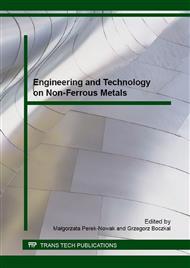[1]
T. Wiślicki, Technologia budowy płatowców, Wydawnictwa Naukowo – Techniczne, Warszawa, 1964, (in Polish).
Google Scholar
[2]
J. Szyndler, L. Madej, Metalforming methods dedicated for aerospace industry, Computer Methods in Materials Science, 2015, 15, in press.
Google Scholar
[3]
M. Tkocz, F. Grosman, Application of incremental metal forming for production of aircraft integral panels, Solid State Phenomena, 2014, 212, 243-246.
DOI: 10.4028/www.scientific.net/ssp.212.243
Google Scholar
[4]
F. Grosman, L. Madej, S. Ziolkiewicz, J. Nowak, Experimental and numerical investigation on development of new incremental forming process, Journal of Materials Processing Technology, 2012, 212, 2200–2209.
DOI: 10.1016/j.jmatprotec.2012.06.014
Google Scholar
[5]
F. Grosman, M. Tkocz, J. Pawlicki, B. Lipska, Wytwarzanie elementów integralnych w procesie kształtowania segmentowego, Hutnik – Wiadomości Hutnicze, 2012, 8, 583-586 (in polish).
Google Scholar
[6]
R. Luri, C.J. Luis, D. Salcedo, J. Leon, J.P. Fuertes, I. Puertas, FEM analysis of the isothermal forging of a connecting rod from material previously deformed by ECAE, Procedia Engineering, 2013, 63, 540-546.
DOI: 10.1016/j.proeng.2013.08.209
Google Scholar
[7]
F. Schongen, F. Klocke, P. Mattfeld, S. Rjasanow, R. Grzhibovskis, FEM/BEM simulation of cold forging process considering press-tool-workpiece interaction, Procedia Engineering, 2014, 81, 2403-2408.
DOI: 10.1016/j.proeng.2014.10.363
Google Scholar
[8]
M. Zhan, H. Yang, Y. Liu, Deformation characteristic of the precision forging of a blade with a damper platform using 3D FEM analysis, Journal of Materials Processing Technology, 2004, 150, 290-299.
DOI: 10.1016/j.jmatprotec.2004.02.062
Google Scholar
[9]
J. Szyndler, L. Madej, F. Grosman, Computer aided development of the innovative incremental forming process, Journal of Machine Engineering, 2014, 14, 1, 84-93.
Google Scholar
[10]
J. Szyndler, K. Perzynski, L. Madej, Modelling of material flow during incremental forming process on the basis of digital material representation concept, Journal of Machine Engineering, 2015, 15, 1, 81-89.
Google Scholar
[11]
L. Madej, J. Wang, K. Perzynski, P.D. Hodgson, Numerical modeling of dual phase microstructure behavior under deformation conditions on the basis of digital material representation, Computational Materials Science, 2014, 95, 651-662.
DOI: 10.1016/j.commatsci.2014.08.035
Google Scholar
[12]
J. Szyndler, L. Madej, Material model development for numerical simulation of the incremental forming process, Conf. Mat. of CMM 21st International Conference on Computer Methods in Mechanics, 2015, in press.
Google Scholar


